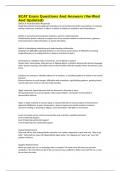Exam (elaborations)
BCAT Exam Questions And Answers (Verified And Updated)
- Course
- Institution
BCAT Exam Questions And Answers (Verified And Updated) Deficits in Social Emotional Reciprocity Range from abnormal social approach and failure of normal back and forth conversations; to reduced sharing of interests, emotions, or affect: to failure to initiate or respond to social interactions. ...
[Show more]



